ASTER-Derived High-Resolution Ice Surface Temperature for the Arctic Coast
Abstract
:1. Introduction
2. Data and Methodology
3. Results
3.1. Comparison MOD29 IST to Near-Surface Air Temperature
3.2. ASTER IST Algorithm
4. Discussion
5. Conclusions
Author Contributions
Acknowledgments
Conflicts of Interest
References
- Serreze, M.C.; Stroeve, J. Arctic sea ice trends, variability and implications for seasonal ice forecasting. Philos. Trans. R. Soc. A 2015, 373, 20140159. [Google Scholar] [CrossRef] [PubMed]
- Schweiger, A.J.; Lindsay, R.W.; Vavrus, S.; Francis, J.A. Relationships between Arctic sea ice and clouds during autumn. J. Clim. 2008, 21, 4799–4810. [Google Scholar] [CrossRef]
- Taylor, P.C.; Kato, S.; Xu, K.-M.; Cai, M. Covariance between Arctic sea ice and clouds within atmospheric state regimes at the satellite footprint level. J. Geophys. Res. Atmos. 2015, 120, 12656–12678. [Google Scholar] [CrossRef] [PubMed]
- Simmonds, I. Comparing and contrasting the behaviour of Arctic and Antarctic sea ice over the 35 year period 1979–2013. Ann. Glaciol. 2015, 56, 18–28. [Google Scholar] [CrossRef]
- Murray, R.J.; Simmonds, I. Responses of climate and cyclones to reductions in Arctic winter sea ice. J. Geophys. Res. Ocean. 1995, 100, 4791–4806. [Google Scholar] [CrossRef]
- Simmonds, I.; Burke, C.; Keay, K. Arctic Climate Change as Manifest in Cyclone Behavior. J. Clim. 2008, 21, 5777–5796. [Google Scholar] [CrossRef]
- Blunden, J.; Arndt, D.S. State of the climate in 2012. Bull. Am. Meteorol. Soc. 2013, 94, S1–S258. [Google Scholar] [CrossRef]
- Barnhart, K.R.; Overeem, I.; Anderson, R.S. The effect of changing sea ice on the physical vulnerability of Arctic coasts. Cryosphere 2014, 8, 1777–1799. [Google Scholar] [CrossRef]
- Meier, W.N.; Hovelsrud, G.K.; van Oort, B.E.; Key, J.R.; Kovacs, K.M.; Michel, C.; Haas, C.; Granskog, M.A.; Gerland, S.; Perovich, D.K.; et al. Arctic sea ice in transformation: A review of recent observed changes and impacts on biology and human activity. Rev. Geophys. 2014, 52, 185–217. [Google Scholar] [CrossRef]
- Druckenmiller, M.L.; Eicken, H.; Johnson, M.; Pringle, D.; Williams, C. Towards an integrated coastal sea-ice observatory: System components and a case study at Barrow, Alaska. Cold Reg. Sci. Technol. 2009, 56, 61–72. [Google Scholar] [CrossRef]
- Liu, Y.; Key, J.; Mahoney, R. Sea and freshwater ice concentration from VIIRS on suomi NPP and the future JPSS satellites. Remote Sens. 2016, 8, 523. [Google Scholar] [CrossRef]
- Ciappa, A.; Pietranera, L.; Budillon, G. Observations of the Terra Nova Bay (Antarctica) polynya by MODIS ice surface temperature imagery from 2005 to 2010. Remote Sens. Environ. 2012, 119, 158–172. [Google Scholar] [CrossRef]
- Aulicino, G.; Sansiviero, M.; Paul, S.; Cesarano, C.; Fusco, G.; Wadhams, P.; Budillon, G. A new approach for monitoring the Terra Nova Bay polynya through MODIS ice surface temperature imagery and its validation during 2010 and 2011 winter seasons. Remote Sens. 2018, 10, 366. [Google Scholar] [CrossRef]
- Hirano, D.; Fukamachi, Y.; Watanabe, E.; Ohshima, K.I.; Iwamoto, K.; Mahoney, A.R.; Eicken, H.; Simizu, D.; Tamura, T. A wind-driven, hybrid latent and sensible heat coastal polynya off Barrow, Alaska. J. Geophys. Res. Ocean. 2016, 121, 980–997. [Google Scholar] [CrossRef]
- Key, J.R.; Collins, J.B.; Fowler, C.; Stone, R.S. High latitude surface temperature estimates from thermal satellite data. Remote Sens. Environ. 1997, 61, 302–309. [Google Scholar] [CrossRef]
- Hall, D.; Key, J.; Casey, K.; Riggs, G.; Cavalieri, D. Sea ice surface temperature product from MODIS. IEEE Trans. Geosci. Remote Sens. 2004, 42, 1076–1087. [Google Scholar] [CrossRef]
- Key, J.; Mahoney, R.; Liu, Y.; Romanov, P.; Tschudi, M.; Appel, I.; Maslanik, J.; Baldwin, D.; Wang, X.; Meade, P. Snow and ice products from Suomi NPP VIIRS. J. Geophys. Res. Atmos. 2013, 118, 12816–12830. [Google Scholar] [CrossRef]
- Gillespie, A.; Rokugawa, S.; Matsunaga, J.S.; Cothern, S.; Kahle, A.B. Temperature and emissivity separation algorithm for Advanced Spaceborne Thermal Emission and Reflection Radiometer (ASTER) images. IEEE Trans. Geosci. Remote Sens. 1998, 36, 1113–1126. [Google Scholar] [CrossRef]
- Jimenez-Munoz, J.C.; Sobrino, J.A. Feasibility of retrieving land-surface temperature from ASTER TIR bands using two-channel algorithms: A case study of agricultural areas. IEEE Geosci. Remote Sens. Lett. 2007, 4, 60–64. [Google Scholar] [CrossRef]
- Wang, K.; Liang, S. Evaluation of ASTER and MODIS land surface temperature and emissivity products using long-term surface longwave radiation observations at SURFRAD sites. Remote Sens. Environ. 2009, 113, 1556–1565. [Google Scholar] [CrossRef]
- Tonooka, H.; Palluconi, F. Validation of ASTER/TIR standard atmospheric correction using water surfaces. IEEE Trans. Geosci. Remote Sens. 2005, 43, 2769–2777. [Google Scholar] [CrossRef]
- Matsuoka, Y.; Kawamura, H.; Sakaida, F.; Hosoda, K. Retrieval of high-resolution sea surface temperature data for Sendai Bay, Japan, using the advanced spaceborne thermal emission and reflection radiometer (ASTER). Remote Sens. Environ. 2011, 115, 205–213. [Google Scholar] [CrossRef]
- Key, J.; Haefliger, M. Arctic ice surface-temperature retrieval from AVHRR thermal channels. J. Geophys. Res. Atmos. 1992, 97, 5885–5893. [Google Scholar] [CrossRef]
- Liu, Y.; Noumi, Y.; Yamaguchi, Y. Discrepancy between ASTER- and MODIS- derived land surface temperatures: Terrain effects. Sensors 2009, 9, 1054–1066. [Google Scholar] [CrossRef] [PubMed]
- Markham, B.L.; Barker, J.L. Thematic mapper band pass solar exoatmospherical Irradiances. Int. J. Remote Sens. 1987, 8, 517–523. [Google Scholar] [CrossRef]
- McIntire, T.J.; Simpson, J.J. Arctic sea ice, cloud, water, and lead classification using neural networks and 1.6 µm data. IEEE Trans. Geosci. Remote Sens. 2002, 40, 1956–1972. [Google Scholar] [CrossRef]
- McMillin, L.M. Estimation of sea surface temperatures from two infrared window measurements with different absorption. J. Geophys. Res. 1975, 80, 5113–5117. [Google Scholar] [CrossRef]
- Barton, I.J.; Zavody, A.M.; O’Brien, D.M.; Cutten, D.R.; Saunders, R.W.; Llewellyn-Jones, D.T. Theoretical algorithms for satellite-derived sea surface temperatures. J. Geophys. Res. 1989, 94, 3365–3375. [Google Scholar] [CrossRef]
- Vincent, R.F.; Marsden, R.F.; Minnett, P.J.; Buckley, J.R. Arctic waters and marginal ice zones: 2. An investigation of arctic atmospheric infrared absorption for advanced very high resolution radiometer sea surface temperature estimates. J. Geophys. Res. 2008, 113. [Google Scholar] [CrossRef]
- Ditri, A.L.; Minnett, P.J.; Liu, Y.; Kilpatrick, K.; Kumar, A. The Accuracies of Himawari-8 and MTSAT-2 sea-surface temperatures in the tropical western Pacific Ocean. Remote Sens. 2018, 10, 212. [Google Scholar] [CrossRef]
- Jordan, R.E.; Andreas, E.L.; Makshtas, A.P. Heat budget of snow-covered sea ice at North Pole 4. J. Geophys. Res. 1999, 104, 7785–7806. [Google Scholar] [CrossRef]
- Persson, P.O.G.; Fairall, C.W.; Andreas, E.L.; Guest, P.S.; Perovich, D.K. Measurements near the atmospheric surface flux group tower at SHEBA: Near-surface conditions and surface energy budget. J. Geophys. Res. 2002, 107, 8045. [Google Scholar] [CrossRef]
- Scambos, T.A.; Haran, T.M.; Massom, R. Validation of AVHRR and MODIS ice surface temperature products using in situ radiometers. Ann. Glaciol. 2006, 44, 345–351. [Google Scholar] [CrossRef]
- Hall, D.K.; Box, J.E.; Casey, K.A.; Hook, S.J.; Shuman, C.A.; Steffen, K. Comparison of satellite-derived and in-situ observations of ice and snow surface temperatures over Greenland. Remote Sens. Environ. 2008, 112, 3739–3749. [Google Scholar] [CrossRef]
- Price, J.C. Estimating surface temperatures from satellite thermal infrared data-A simple formulation for the atmospheric effect. Remote Sens. Environ. 1983, 13, 353–361. [Google Scholar] [CrossRef]
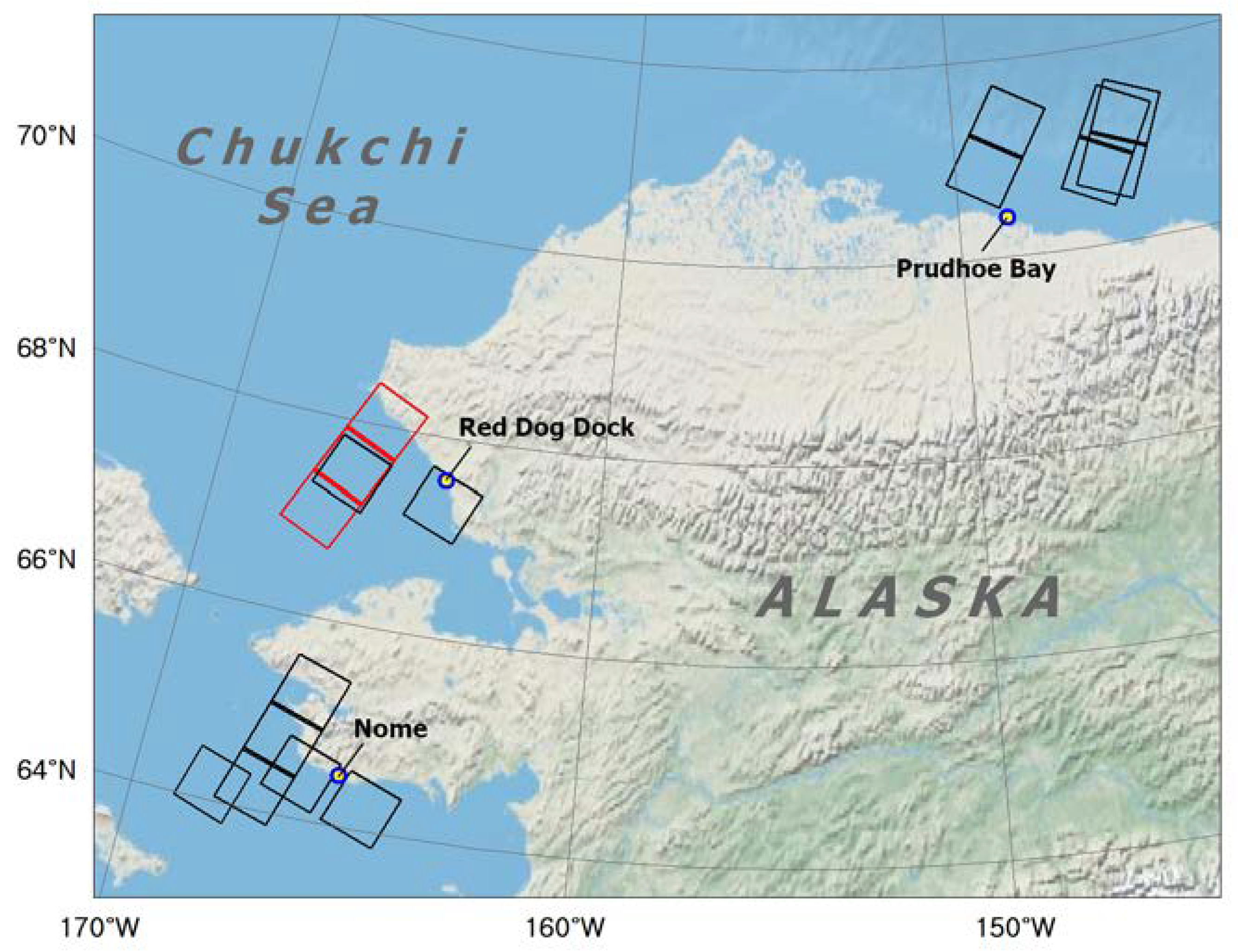
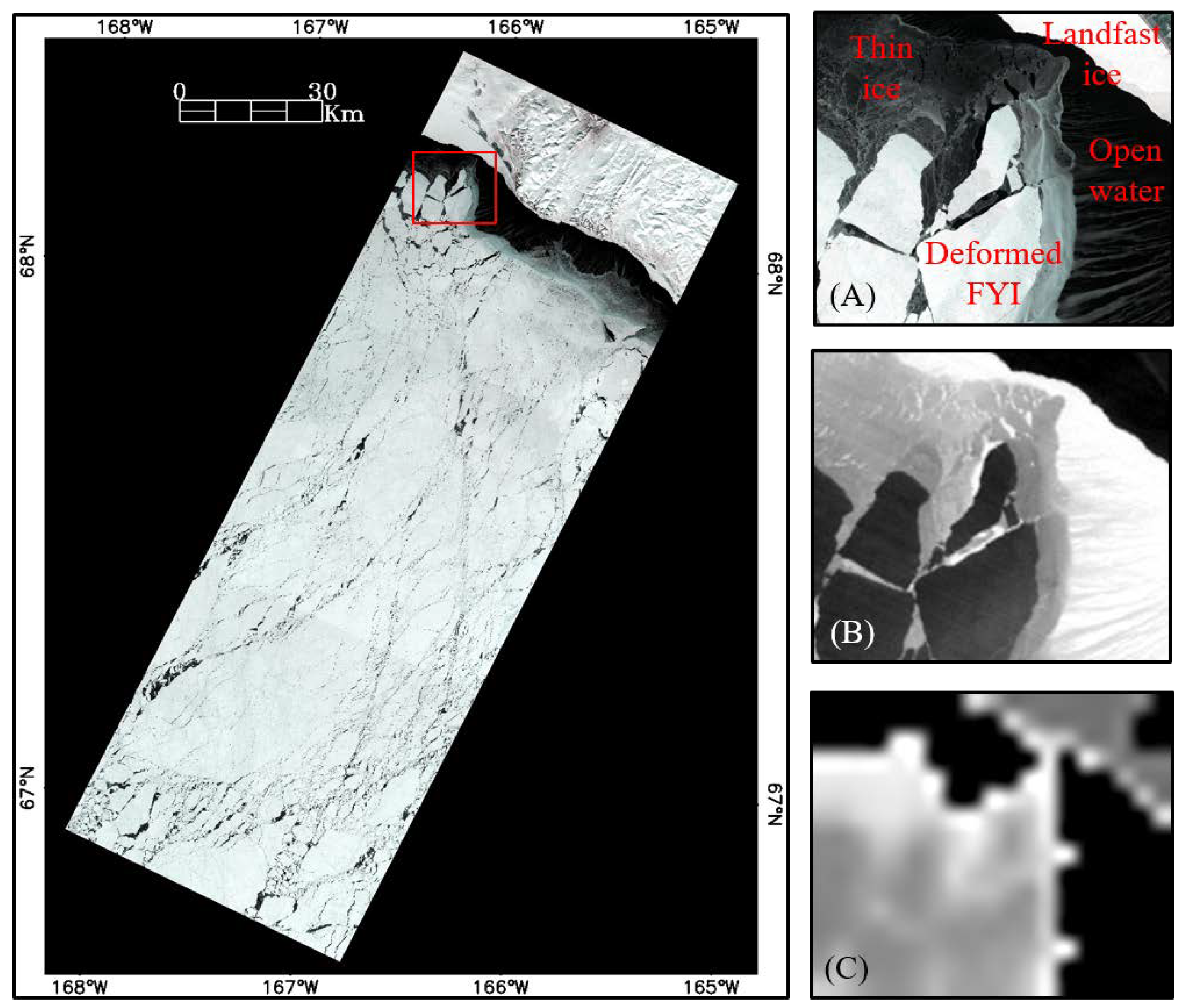
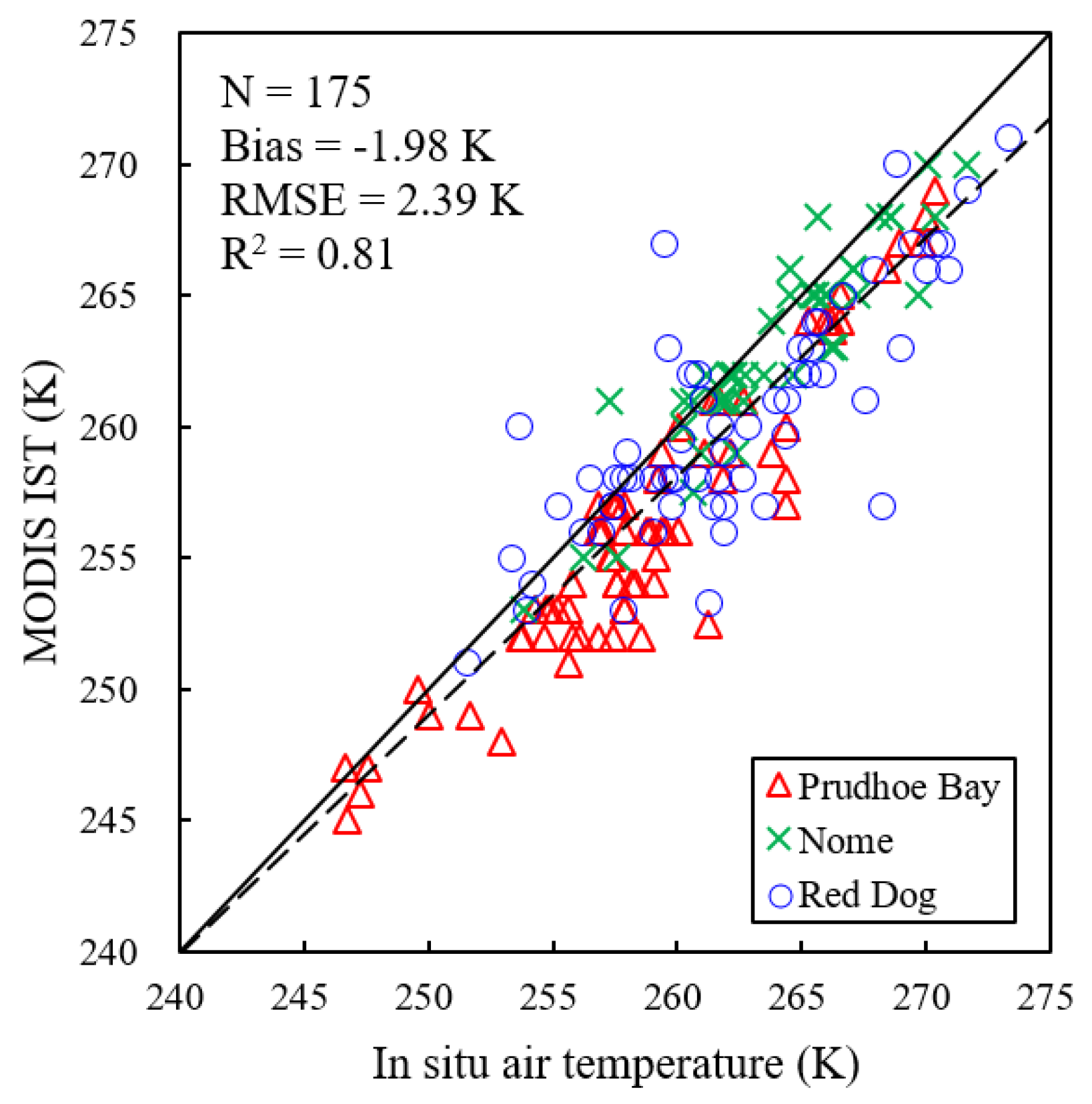
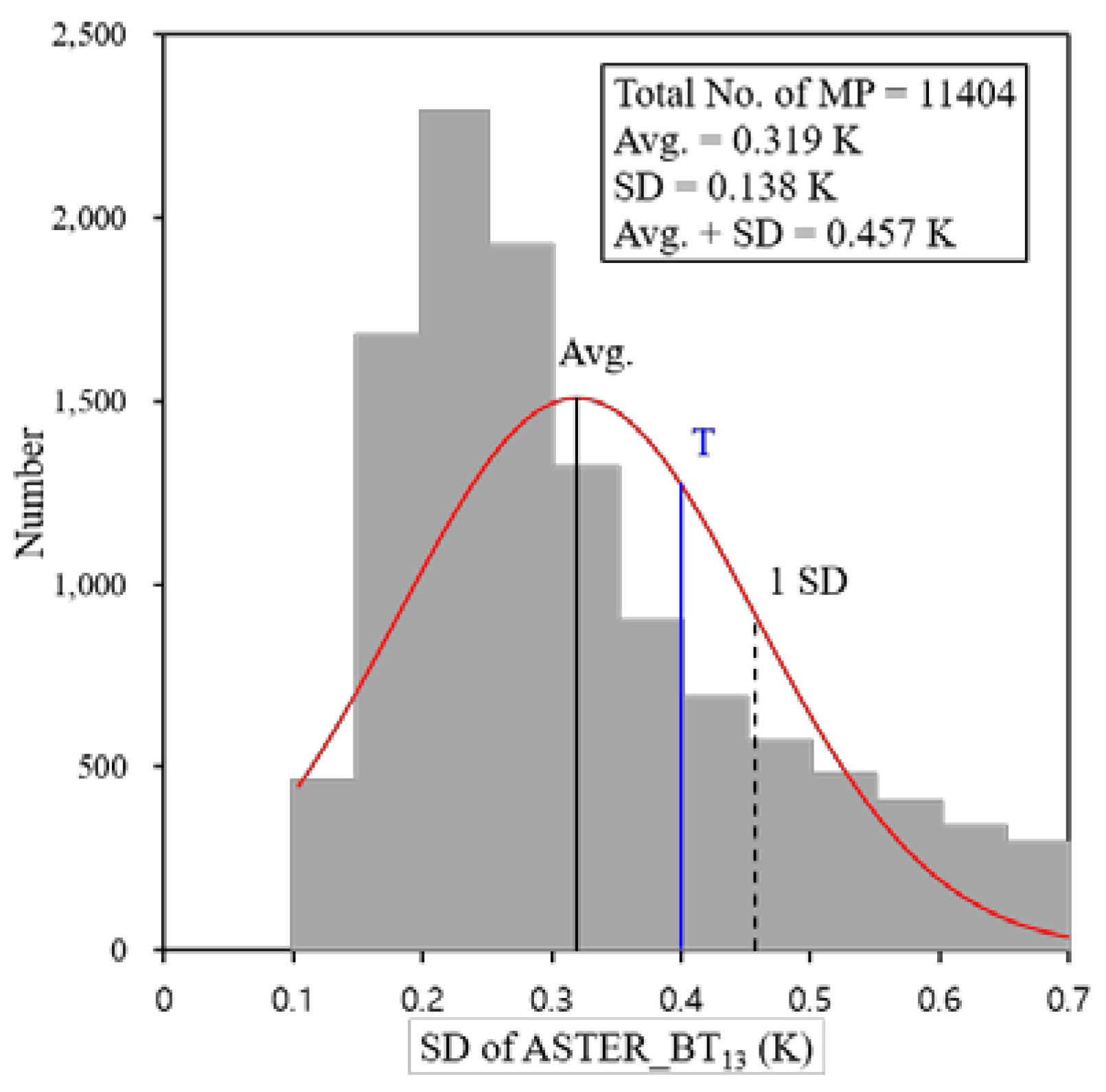
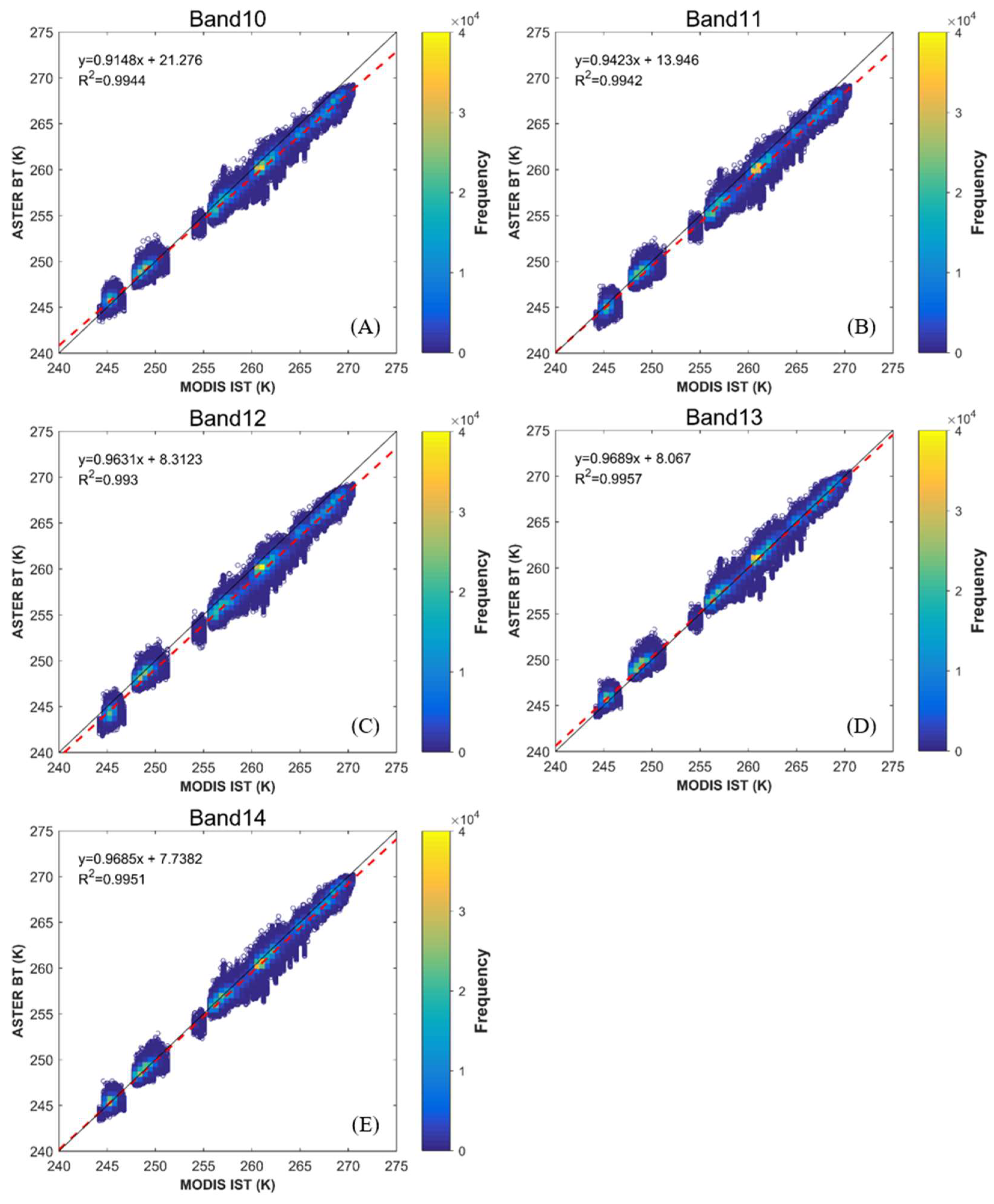
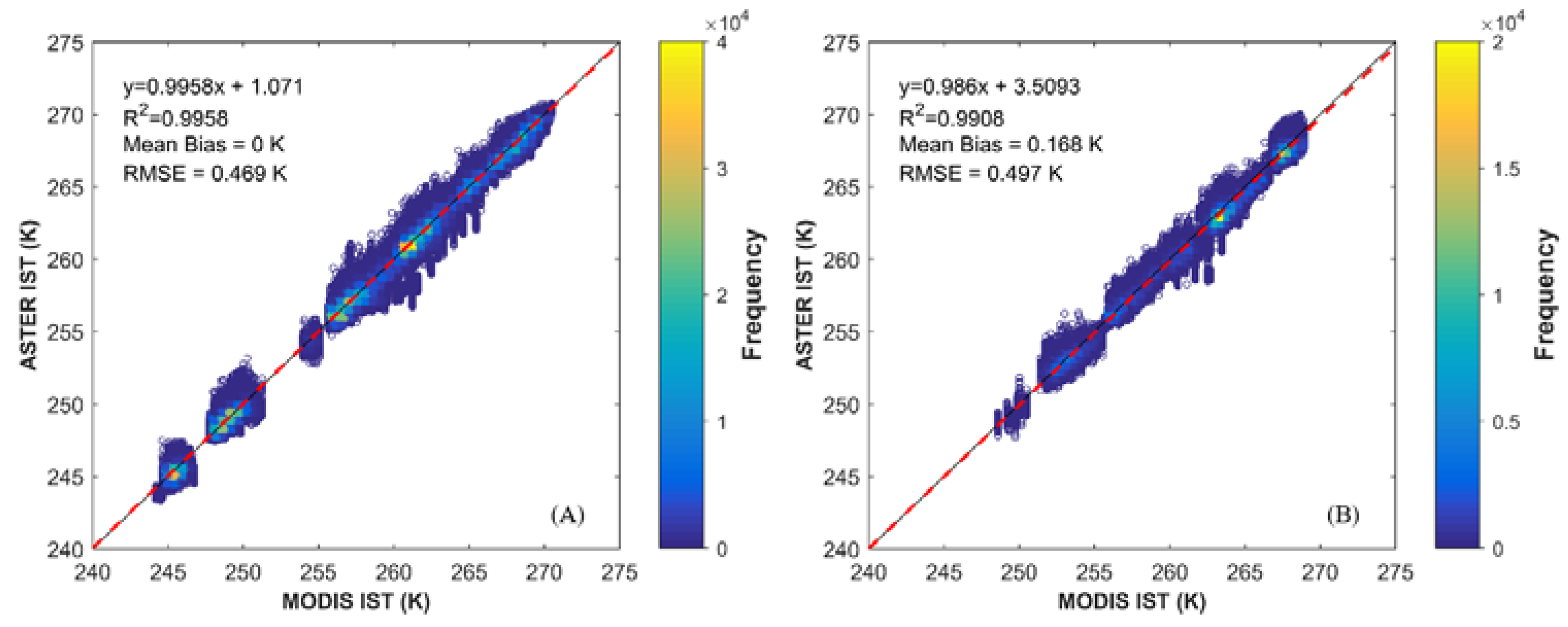

| Sensor | TIR Band No. | Spectral Range (μm) | Spatial Resolution |
|---|---|---|---|
| AVHRR | 4 | 10.30–11.30 | 1.09 km |
| 5 | 11.50–12.50 | ||
| MODIS | 31 | 10.78–11.28 | 1 km |
| 32 | 11.77–12.27 | ||
| VIIRS | M14 | 8.40–8.70 | 750 m |
| M15 | 10.263–11.263 | ||
| M16 | 11.538–12.488 | ||
| Landsat-8 | 10 | 10.30–11.30 | 100 m |
| 11 | 11.50–12.50 | ||
| ASTER | 10 | 8.125–8.475 | 90 m |
| 11 | 8.475–8.825 | ||
| 12 | 8.925–9.275 | ||
| 13 | 10.25–10.95 | ||
| 14 | 10.95–11.65 |
| Type 1 | Region | ASTER Scene Date 2 | MODIS Pixel (Match-Up) 3 | MODIS IST Range (K) | Mean (SD) 4 (K) |
|---|---|---|---|---|---|
| D | Nome | 9 March 2001 | 78 (54) | 263.75–269.13 | 0.334 (0.13) |
| 26 April 2001 | 526 (526) | 267.8–270.52 | 0.168 (0.037) | ||
| 2 April 2004 | 475 (339) | 259.04–264.36 | 0.337 (0.131) | ||
| 14 April 2005 *** | 1144 (1069) | 260.02–270.06 | 0.239 (0.09) | ||
| Red Dog | 11 April 2002 | 667 (588) | 259.99–268.91 | 0.281 (0.11) | |
| 11 March 2003 *** | 1637 (1019) | 256.34–266.08 | 0.372 (0.147) | ||
| 20 April 2006 | 864 (541) | 252.98–259.99 | 0.366 (0.139) | ||
| 17 March 2007 | 864 (565) | 252.98–261.76 | 0.363 (0.134) | ||
| Prudhoe | 2 April 2001 ** | 1803 (1530) | 247.76–252.28 | 0.298 (0.112) | |
| 2 May 2002 ** | 1365 (870) | 260.22–264.24 | 0.341 (0.167) | ||
| 16 March 2008 | 1020 (837) | 244.05–246.96 | 0.329 (0.103) | ||
| Total | 17 | 11,404 (7938) | 244.05–270.52 | 0.319 (0.138) | |
| V | Nome | 17 March 2004 ** | 144 (77) | 257.08–261.04 | 0.402 (0.132) |
| 17 March 2007 ** | 877 (563) | 258.03–266.66 | 0.364 (0.162) | ||
| Red Dog | 26 April 2001 | 667 (603) | 266.69–268.91 | 0.27 (0.094) | |
| 24 March 2007 | 862 (596) | 247.56–261.76 | 0.358 (0.129) | ||
| Prudhoe | 3 May 2002 | 908 (614) | 264.23–265.46 | 0.338 (0.143) | |
| Total | 7 | 3458 (2453) | 247.56–268.91 | 0.339 (0.141) |
| Range | ||||||
|---|---|---|---|---|---|---|
| Bias | >240 K | −0.705 | −0.955 | −1.197 | 0.031 | −0.402 |
| 240–260 K | 0.26 | −0.676 | −1.029 | 0.173 | −0.247 | |
| >260 K | −1.179 | −1.252 | −1.375 | −0.12 | −0.568 | |
| RMSE | >240 K | 1.06 | 1.167 | 1.361 | 0.515 | 0.678 |
| 240–260 K | 0.749 | 0.943 | 1.226 | 0.547 | 0.592 | |
| >260 K | 1.321 | 1.365 | 1.492 | 0.479 | 0.759 |
| Range | a | b | c | d | e | f | |
|---|---|---|---|---|---|---|---|
| 2 Ch | >240 K | −7.13193 | 1.02792 | −0.24093 | |||
| 240–260 K | −9.26874 | 1.03662 | −0.35169 | ||||
| >260 K | −5.95003 | 1.02318 | −0.11206 | ||||
| 5 Ch | >240 K | −9.733 | 0.149995 | 0.082399 | 0.028279 | 0.599756 | 0.178344 |
| 240–260 K | −12.9486 | 0.226197 | 0.073846 | −0.08225 | 0.552123 | 0.281406 | |
| >260 K | −8.60318 | 0.036583 | 0.134919 | 0.132995 | 0.697087 | 0.032862 |
| Type 1 | Coefficient | 2 Ch | 5 Ch | |
|---|---|---|---|---|
| D | All range | Bias | 0 | 0 |
| RMSE | 0.471 | 0.467 | ||
| Divided range | Bias | 0 | 0 | |
| RMSE | 0.469 | 0.462 | ||
| V | All range | Bias | 0.17 | 0.209 |
| RMSE | 0.497 | 0.507 | ||
| Divided range | Bias | 0.168 | 0.472 | |
| RMSE | 0.497 | 0.746 |
© 2018 by the authors. Licensee MDPI, Basel, Switzerland. This article is an open access article distributed under the terms and conditions of the Creative Commons Attribution (CC BY) license (http://creativecommons.org/licenses/by/4.0/).
Share and Cite
Son, Y.-S.; Kim, H.-c.; Lee, S.J. ASTER-Derived High-Resolution Ice Surface Temperature for the Arctic Coast. Remote Sens. 2018, 10, 662. https://doi.org/10.3390/rs10050662
Son Y-S, Kim H-c, Lee SJ. ASTER-Derived High-Resolution Ice Surface Temperature for the Arctic Coast. Remote Sensing. 2018; 10(5):662. https://doi.org/10.3390/rs10050662
Chicago/Turabian StyleSon, Young-Sun, Hyun-cheol Kim, and Sung Jae Lee. 2018. "ASTER-Derived High-Resolution Ice Surface Temperature for the Arctic Coast" Remote Sensing 10, no. 5: 662. https://doi.org/10.3390/rs10050662






